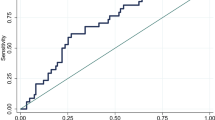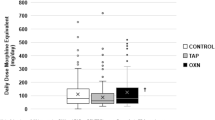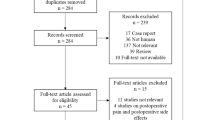Abstract
Objective: Within the past decade, human experimental pain studies have supported the 50-year-old hypothesis that codeine is a prodrug, which has to be converted to morphine to exert an analgesic effect. This study aimed at evaluating the impact of sparteine phenotype and serum concentrations of morphine on the efficacy of codeine in post-operative pain.
Methods: Eighty-one patients with a pain rating of 3 or more on a 0–10 numerical rating scale 0.5 h after surgery were included in the study. The patients were given an oral dose of 100 mg codeine and rated pain with the numerical rating scale 0.5 h and 1 h after medication. Blood for determination of serum concentration of codeine and its metabolites was collected 1 h after medication, and a 12-h urine sample after administration of 100 mg sparteine was used to determine the sparteine phenotype.
Results: Eight patients were poor metabolizers and 66 were extensive metabolizers of sparteine, while the urine samples for the remaining seven patients were lost. In 22 patients, including the eight poor metabolizers, the serum concentrations of both morphine and morphine-6-glucuronide (M6G) were below the limit of determination of the assay, i.e. 1.5 nmol · l−1 and 2 nmol · l−1, respectively. A sum of the concentration of these two substances below 10 nmol · l−1 was found in an additional eight patients. The sum of differences between pre- and post-operative pain ratings did not differ between the two phenotypes (P= 0.60), whereas the 30 patients with serum concentrations of morphine plus M6G below 10 nmol · l−1 had a marginally significant lower sum than the 51 patients with higher levels of these substances (median 1.5 vs 2.5, P = 0.058).
Conclusion: A low serum concentration of morphine and M6G seems to be common in patients treated with codeine for post-operative pain, and low concentrations of these active substances may be related to decreased efficacy of codeine.
Similar content being viewed by others
Author information
Authors and Affiliations
Additional information
Received: 23 September 1997 / Accepted in revised form: 11 May 1998
Rights and permissions
About this article
Cite this article
Poulsen, L., Riishede, L., Brøsen, K. et al. Codeine in post-operative pain Study of the influence of sparteine phenotype and serum concentrations of morphine and morphine-6-glucuronide. E J Clin Pharmacol 54, 451–454 (1998). https://doi.org/10.1007/s002280050491
Issue Date:
DOI: https://doi.org/10.1007/s002280050491




